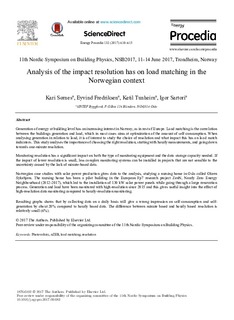| dc.contributor.author | Sørnes, Kari | |
| dc.contributor.author | Fredriksen, Eyvind | |
| dc.contributor.author | Tunheim, Ketil | |
| dc.contributor.author | Sartori, Igor | |
| dc.date.accessioned | 2017-11-28T07:07:12Z | |
| dc.date.available | 2017-11-28T07:07:12Z | |
| dc.date.created | 2017-11-27T09:24:50Z | |
| dc.date.issued | 2017 | |
| dc.identifier.citation | Energy Procedia. 2017, 132 610-615. | nb_NO |
| dc.identifier.issn | 1876-6102 | |
| dc.identifier.uri | http://hdl.handle.net/11250/2468187 | |
| dc.description.abstract | Generation of energy at building level has an increasing interest in Norway, as in rest of Europe. Load matching is the correlation between the buildings generation and load, which in most cases aims at optimization of the amount of self-consumption. When analysing generation in relation to load, it is of interest to study the choice of resolution and what impact this has on load match indicators. This study analyses the importance of choosing the right resolution, starting with hourly measurements, and going down towards one-minute resolution. Monitoring resolution has a significant impact on both the type of monitoring equipment and the data storage capacity needed. If the impact of lower resolution is small, less complex monitoring systems can be installed in projects that are not sensible to the uncertainty caused by the lack of minute-based data. Norwegian case studies with solar power production gives data to the analysis, studying a nursing home in Oslo called Økern Sykehjem. The nursing home has been a pilot building in the European Fp7 research project ZenN, Nearly Zero Energy Neighbourhood (2012-2017), which led to the installation of 130 kW solar power panels while going through a large renovation process. Generation and load have been monitored with high-resolution since 2015 and this gives useful insight into the effect of high-resolution data monitoring compared to hourly-resolution monitoring. Resulting graphs shows that by collecting data on a daily basis will give a wrong impression on self-consumption and self-generation by about 20% compared to hourly based data. The difference between minute based and hourly based resolution is relatively small (6%) | nb_NO |
| dc.language.iso | eng | nb_NO |
| dc.publisher | Elsevier Ltd. | nb_NO |
| dc.rights | Attribution-NonCommercial-NoDerivatives 4.0 Internasjonal | * |
| dc.rights.uri | http://creativecommons.org/licenses/by-nc-nd/4.0/deed.no | * |
| dc.subject | Complex monitoring system | nb_NO |
| dc.subject | Data storage capacity | nb_NO |
| dc.subject | High resolution data | nb_NO |
| dc.subject | Impact resolution | nb_NO |
| dc.subject | Load matching | nb_NO |
| dc.subject | Monitoring equipment | nb_NO |
| dc.subject | nZEB | nb_NO |
| dc.subject | Photovoltaic; PV | nb_NO |
| dc.subject | Buildings | nb_NO |
| dc.subject | Digital storage | nb_NO |
| dc.subject | Solar energy | nb_NO |
| dc.title | Analysis of the impact resolution has on load matching in the Norwegian context | nb_NO |
| dc.title.alternative | Nordic Symposium on Building Physics, NSB 2017, June 11, 2017 | nb_NO |
| dc.type | Journal article | nb_NO |
| dc.type | Peer reviewed | nb_NO |
| dc.description.version | publishedVersion | nb_NO |
| dc.rights.holder | © The authors | nb_NO |
| dc.subject.nsi | VDP::Technology: 500 | nb_NO |
| dc.source.pagenumber | 610-615 | nb_NO |
| dc.source.volume | 132 | nb_NO |
| dc.source.journal | Energy Procedia | nb_NO |
| dc.identifier.doi | 10.1016/j.egypro.2017.09.683 | |
| dc.identifier.cristin | 1518648 | |
| cristin.unitcode | 7401,30,20,0 | |
| cristin.unitname | Bygninger og installasjoner | |
| cristin.ispublished | true | |
| cristin.fulltext | original | |
| cristin.qualitycode | 1 | |

